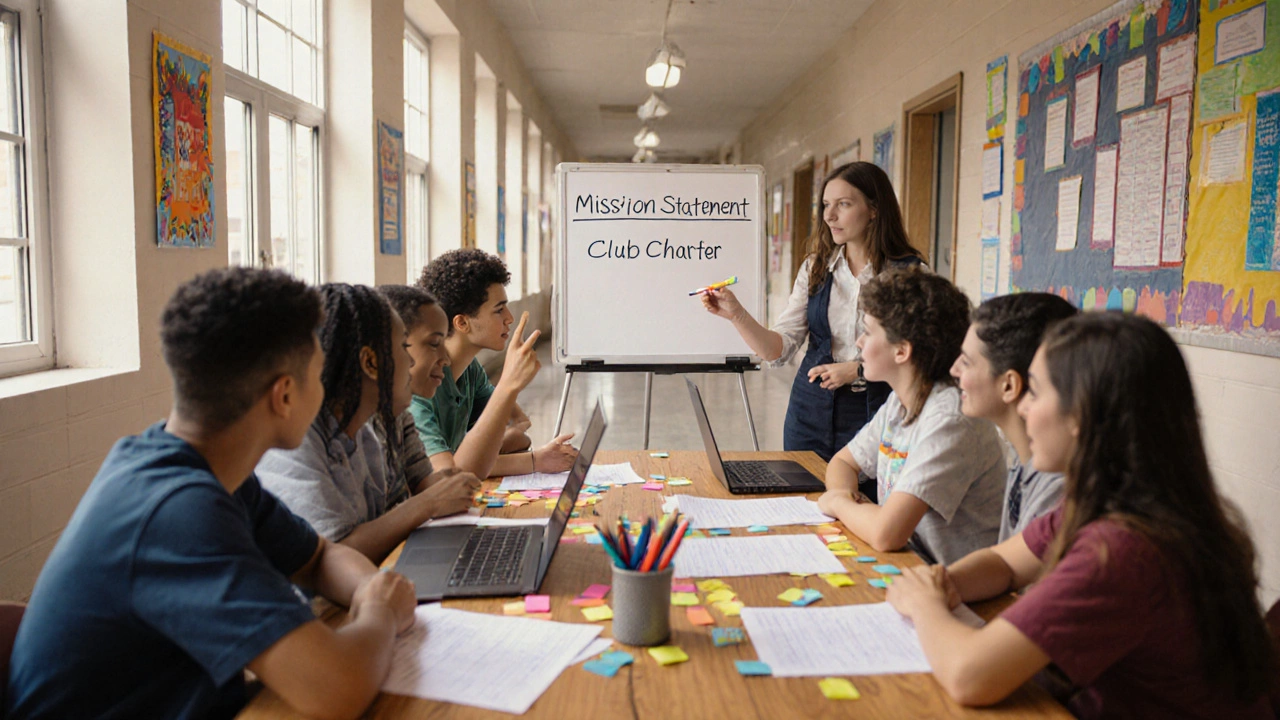Club Growth Calculator
Estimate Your Club Growth
Calculate potential new members based on recruitment channels and retention strategies from the article.
Growth Estimate
Projected New Members
0
Total Membership
0
Growth Rate
Based on article strategies: Multi-channel recruitment, mentorship programs, and regular feedback
Looking to boost the size and impact of your School Club is an organized group of students that meets regularly to pursue a shared interest, often after school hours? Whether you’re a teacher adviser, a student president, or a parent volunteer, expanding a club can feel overwhelming. You need clear goals, a solid structure, and a plan that reaches the right kids. Below is a step‑by‑step playbook that walks you through every stage of school club expansion - from defining purpose to keeping members engaged year after year.
Set a Clear Vision and Write a Club Charter
The first job is to answer the "why" behind the club. A well‑crafted charter outlines the mission, target audience, meeting cadence, and success metrics. It becomes a reference point when you pitch to the school board or potential sponsors.
- Mission statement - one sentence that captures the core purpose.
- Goals - measurable targets like "increase membership by 30% in one term" or "host three community events".
- Structure - roles, meeting frequency, and decision‑making process.
Document the charter on a shared drive so new leaders can pick it up easily.
Build a Strong Leadership Team
Growth stalls without a capable crew. Recruit a small leadership squad that reflects diverse skills: a president, a treasurer, a communications officer, and a events coordinator.
When you first mention Club Leadership is the group of officers and advisors responsible for steering the club’s direction, managing resources, and motivating members, clarify each role’s responsibilities. Provide a short training session covering meeting facilitation, budgeting basics, and conflict resolution. Empower the team to make decisions without micromanaging you.
Secure Funding and Resources
Even a modest club needs money for supplies, snacks, or event fees. Identify three funding streams early on:
- School allocated budgets - submit a concise proposal referencing your charter.
- Local business sponsorships - offer a thank‑you banner or social media shout‑out.
- Member dues - keep fees low (e.g., $5 per term) and clearly explain what they cover.
When you first bring up Funding is the financial support obtained from school, community partners, or member contributions to sustain club activities, include a simple spreadsheet template so leaders can track income and expenses.
Design an Engaging Programme
Kids join clubs that promise fun, learning, and a sense of belonging. Schedule a mix of low‑commitment meet‑ups and showcase events.
Introduce Student Engagement is the level of interest, participation, and emotional connection that members have with club activities metrics early: attendance rates, survey scores, and the number of ideas contributed by members.
Typical programme elements:
- Weekly skill‑building workshops (15‑30 min).
- Monthly guest speakers from the community.
- Quarterly showcase or competition.
Each session should end with a quick feedback poll - that data fuels future planning.

Market the Club Effectively
Even the best programme flops if nobody knows it exists. Blend traditional and digital tactics.
First, define your Marketing is the set of strategies used to promote the club, attract members, and build its public profile message: "Join us to learn X, meet friends, and have fun!" Keep branding consistent - same colors, logo, and tagline.
Channels to consider:
- School announcement screens - short 15‑second video.
- Posters in corridors - bright visuals + QR code linking to a sign‑up form.
- Instagram or TikTok - student‑run reels showing club highlights.
- Classroom presentations - 5‑minute pitch during homeroom.
Measure reach by tracking QR scan counts, sign‑up form submissions, and attendance spikes after each push.
Recruit Members Using Multiple Touchpoints
Relying on a single recruitment method limits diversity. Below is a quick comparison of the most common channels.
| Channel | Typical Reach | Cost | Effort | Effectiveness |
|---|---|---|---|---|
| Social Media (Instagram/TikTok) | High (200+ students) | Low (free) | Medium (content creation) | High |
| Posters & Flyers | Medium (50‑100 students) | Low‑Medium (printing) | Low (design & placement) | Medium |
| Classroom Presentations | Medium (30‑40 per class) | None | Medium (prep time) | High |
| Teacher Referrals | Low‑Medium (depends on teacher) | None | Low (ask teachers) | Medium‑High |
| Peer Ambassadors | High (network effect) | None | Medium (train ambassadors) | Very High |
Combine at least two channels for each recruitment cycle. For example, launch a TikTok teaser one week, then follow up with classroom presentations the next.
Forge Partnerships with School and Community
Support from school staff and local organisations adds credibility and resources.
Introduce School Administration is the principal, vice‑principal, and department heads who approve club activities, allocate rooms, and often provide budgetary support early in the process. Request a brief meeting to share your charter and outline requested resources.
Local partners - museums, NGOs, sports clubs - can donate equipment, host joint events, or provide guest speakers. Draft a one‑page partnership proposal that lists mutual benefits.

Retain Members and Keep Momentum Going
Growth is meaningless if members drop out after a month. Implement a retention framework that includes mentorship, feedback loops, and recognition.
When you first talk about Mentorship Program is a structured system where experienced members guide newcomers, helping them feel welcomed and develop skills faster, pair each new member with a senior buddy for the first six weeks.
Use Volunteer Management is the process of organizing, scheduling, and recognizing volunteers who support the club’s operations to track who helped with events, who led workshops, and who contributed ideas. Celebrate milestones with monthly shout‑outs or small awards.
Regularly revisit the charter goals. If a target is met, set a new one - that signals progress and keeps the leadership team motivated.
Quick Expansion Checklist
- Write or update the club charter with measurable goals.
- Recruit a diverse leadership team and hold a role‑clarification workshop.
- Secure at least two funding sources before the first event.
- Plan a quarterly mix of workshops, guest talks, and showcase events.
- Design a consistent brand (logo, colors, tagline).
- Launch a multi‑channel recruitment campaign every term.
- Schedule meetings with school administrators and at least one community partner.
- Implement a mentorship and volunteer‑recognition system.
Frequently Asked Questions
How many members should a school club have to be considered "successful"?
Success isn’t about a fixed number; it’s about meeting the club’s mission. A good rule of thumb is to have enough members to fill roles (e.g., 5‑10 active participants) while keeping meetings manageable. If you can consistently run events and maintain engagement, you’re on the right track.
Can I run a club without teacher supervision?
Most schools require at least one adult adviser for liability reasons. Approach a teacher who shares an interest in your topic, or ask a parent volunteer to act as the official sponsor.
What are inexpensive ways to fund a club?
Start with low‑cost options: crowdfunding on platforms like GoFundMe, a small bake‑sale, or applying for school‑allocated activity funds. Local businesses often donate supplies in exchange for a thank‑you poster.
How often should the club meet?
Aim for a consistent schedule - weekly or bi‑weekly - that fits students’ timetables. Consistency builds habit; if you can’t meet that often, make each session high‑impact and supplement with online activities.
What should I do if members aren’t showing up?
First, poll the absent members to discover barriers (time, interest, location). Then tweak the format - maybe add a social component or shorten the meeting. Public recognition of attendance can also boost motivation.
How can I measure the club’s impact?
Track three core metrics: membership numbers, event attendance, and post‑event feedback scores. Combine these with qualitative data like student testimonials to build a compelling impact report for sponsors.
Next Steps
Pick one of the eight steps above and start today - even a half‑hour planning session can set the ball rolling. Document what you do, share quick wins with the school community, and watch your club grow from a small circle to a thriving student hub.
